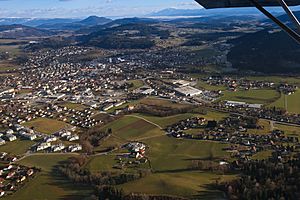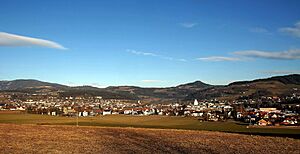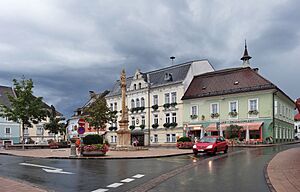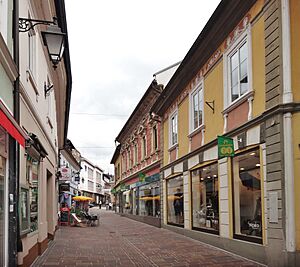Feldkirchen in Kärnten facts for kids
Quick facts for kids
Feldkirchen in Kärnten
|
||
|---|---|---|
 |
||
|
||
| Country | Austria | |
| State | Carinthia | |
| District | Feldkirchen | |
| Area | ||
| • Total | 77.5 km2 (29.9 sq mi) | |
| Elevation | 554 m (1,818 ft) | |
| Population
(2018-01-01)
|
||
| • Total | 14,198 | |
| • Density | 183.20/km2 (474.5/sq mi) | |
| Time zone | UTC+1 (CET) | |
| • Summer (DST) | UTC+2 (CEST) | |
| Postal code |
9560
|
|
| Website | www.feldkirchen.at | |
Feldkirchen in Kärnten is a town in the Austrian state of Carinthia. It is also the main town of the Feldkirchen district. The town is made up of several smaller areas called Katastralgemeinden. These include Fasching, Feldkirchen, Glanhofen, and Waiern. The name Feldkirchen means "the church in the fields."
Contents
Exploring Feldkirchen's Geography
Where is Feldkirchen Located?
Feldkirchen is found on the northern edge of the Klagenfurt Basin. It sits where several main roads meet. These roads connect Feldkirchen to other towns like Friesach, Villach, and Klagenfurt.
Rivers and Lakes in Feldkirchen
Two rivers flow through Feldkirchen: the Glan river and the smaller Tiebel. The Tiebel river is the main water source for Lake Ossiach.
There are also three beautiful lakes close to Feldkirchen:
- The Lake of Flatschach (Flatschacher See)
- The Lake of Dietrichstein (Dietrichsteiner See)
- The Lake of Maltschach (Maltschacher See)
Towns Near Feldkirchen
Feldkirchen is surrounded by several other towns. These include Himmelberg, Steuerberg, Sankt Urban, Steindorf, Glanegg, Ossiach, Velden, Techelsberg, and Moosburg.
A Look at Feldkirchen's History
Early Beginnings
Feldkirchen might have started as a resting place called Beliandrum. This place was along an old Roman road. This road connected two important Roman towns, Teurnia and Virunum. A Roman tombstone from the 2nd century can still be seen in the walls of the Saint Michael church.
First Mentions and Important Buildings
The town was first mentioned in a document in 888. It was called Ueldchiricha, meaning "Church in the Fields." The Maria im Dorn parish church is one of the oldest holy buildings in Carinthia. It is a Romanesque basilica with parts from the Carolingian period.
Feldkirchen was once owned by the Eppenstein noble family. In 1166, it was given to the Diocese of Bamberg, a church group. The bishops built the Amthof, which was once the local government office. Today, the Amthof is used for cultural events and has a small museum.
Becoming a Town
In 1759, Maria Theresa of Austria bought Feldkirchen. The village of Markstein, south of the town, was once a checkpoint. It marked the border between the Austrian Empire and a French-controlled area called the Illyrian Provinces. You can still see an old customs station and a border stone there. Feldkirchen officially became a town in 1930.
Who Lives in Feldkirchen?
According to a census in 2001, Feldkirchen had 14,030 people living there. Most people, about 77.1%, belong to the Roman Catholic Church. About 12.0% are Protestant, and smaller groups belong to the Orthodox Church or are Muslim. About 2.0% of the people do not follow any religion.
Places to See in Feldkirchen
Feldkirchen has several interesting places to visit:
- Catholic parish church Maria im Dorn
- Catholic church St. Michael
- Catholic church St. Martin
- Catholic church St. Ulrich
- Amthof (the old administrative building)
- Antoniusheim
Gallery
Feldkirchen's International Friends
Feldkirchen in Kärnten has "twin towns" or "sister cities." This means they have a special friendship and often share culture and ideas.
Twin Towns
Feldkirchen in Kärnten is twinned with:
Famous People from Feldkirchen
Many interesting people have come from Feldkirchen:
- Otto Maria Polley (1910–1984), a writer.
- Wolfgang Neumann (born 1945), an Austrian opera singer known as a heldentenor.
- Herbert Gantschacher (born 1956), a director, producer, and writer.
- Claudia Arpa (born 1967), a politician who was the President of Austria's Federal Council.
Sport Stars
- Wolfgang Knaller (born 1961), an Austrian football goalkeeper who played over 420 games.
- Klaus Rohseano (born 1969), a retired Austrian football player who played over 310 games.
- Siegfried Grabner (born 1975), a snowboarder who won a bronze medal at the 2006 Winter Olympics.
See also
 In Spanish: Feldkirchen in Kärnten para niños
In Spanish: Feldkirchen in Kärnten para niños













